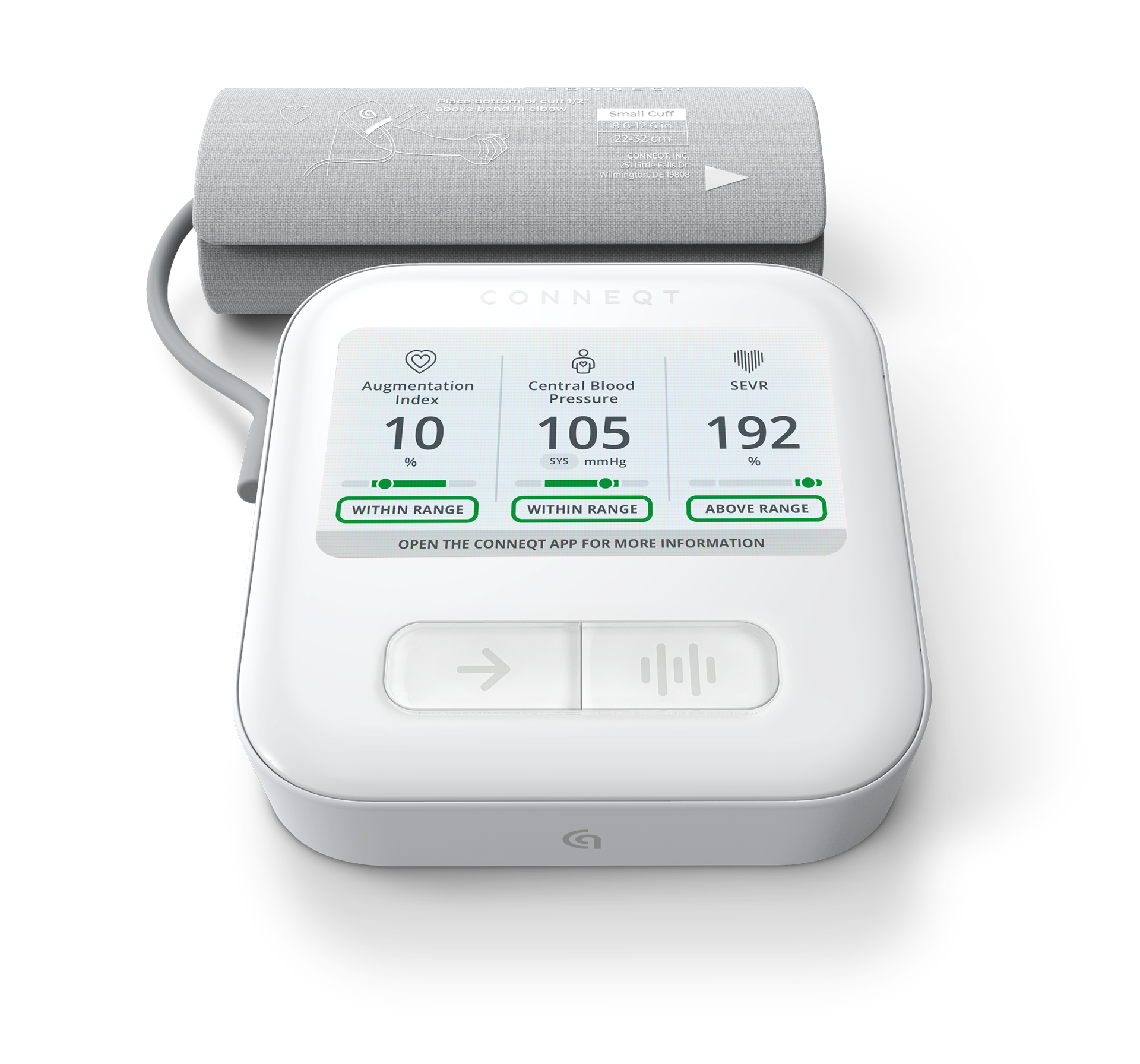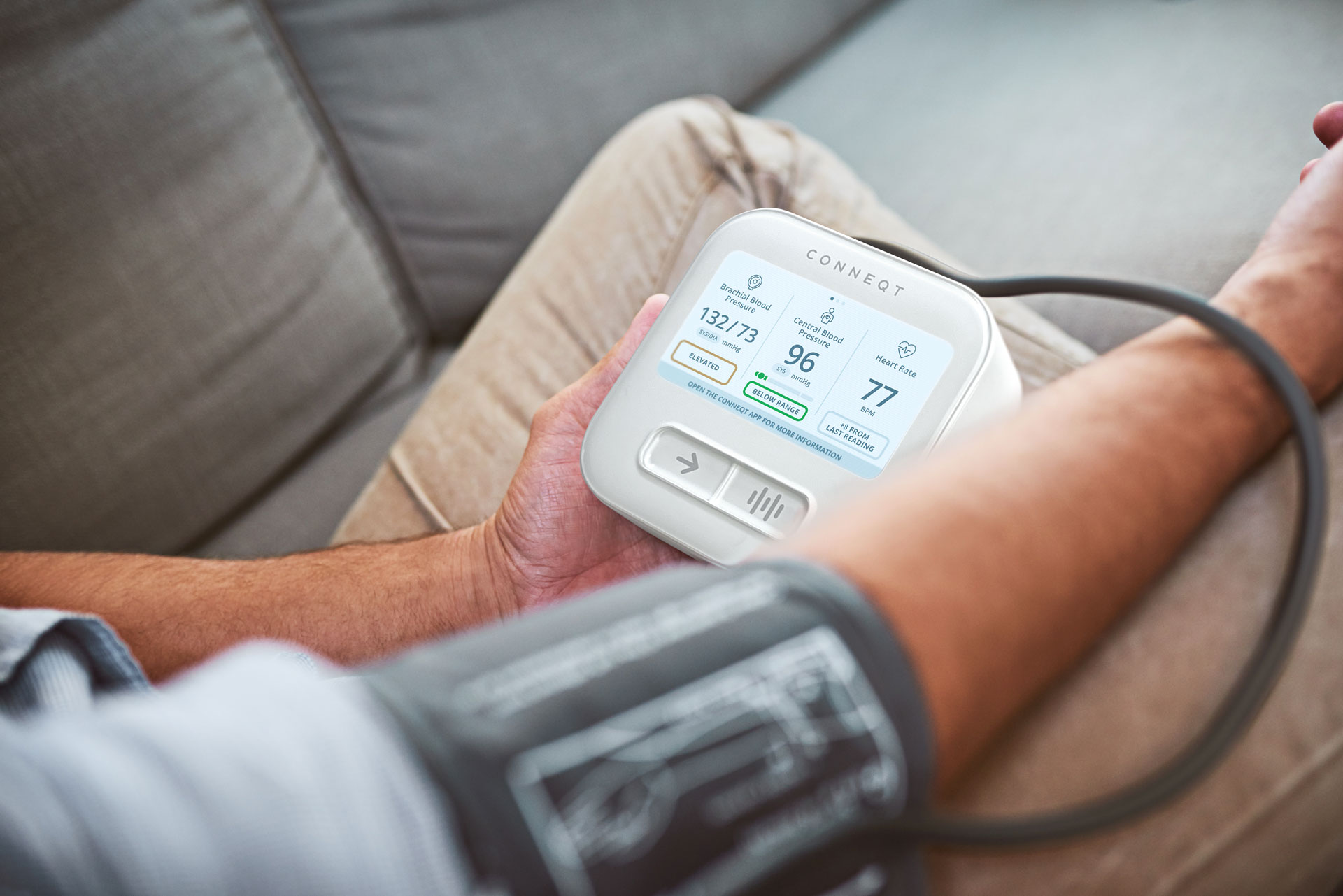Most people think of blood pressure as a single number taken at the arm. But what if your readings tell a more complex story?
If your brachial blood pressure (measured at the arm) is high—but your central blood pressure (measured near the heart and aorta) is low—you may be experiencing a phenomenon known as pressure amplification. It’s not just an unexpected difference in your readings. It could reveal valuable insights into your arterial health, cardiovascular efficiency, and even your long-term risk of heart disease.

Measure what matters
Save 20% on checkout with code VITALITY
Let’s break down what it means—and why it matters.
Understanding Pressure Amplification

As blood travels from your heart through large, elastic arteries and out to smaller, muscular arteries like the brachial artery in your arm, the pressure can actually increase. This is due to natural wave reflections off the walls of your arteries, a normal part of how the circulatory system works.
In healthy, flexible arteries, these wave reflections tend to return after the heart has finished contracting. The result? Your brachial systolic pressure (the top number) may appear higher than your central systolic pressure. This is particularly true for younger adults or those with good arterial elasticity.
This widening of pressure from the center of your body to the periphery is called pulse pressure amplification (PPA). And it’s more than just a measurement—it’s a window into how your arteries are functioning.
Why It Happens
Pulse pressure amplification depends largely on arterial stiffness and wave timing:
- In compliant, youthful arteries, the reflected wave returns during diastole (when the heart is resting), which boosts peripheral pressure without increasing the workload on the heart.
- In stiffer or aging arteries, the reflected wave returns earlier, during systole (when the heart is contracting). This raises central pressure and increases cardiac strain.
So when amplification is high, your arteries may be doing their job well. When it’s low, it could point to early signs of vascular aging—even before traditional symptoms or brachial readings catch on.
Why Central Pressure Tells a Different Story
Here’s where things get interesting: central blood pressure is often a better predictor of cardiovascular events like heart attacks, strokes, and organ damage than brachial pressure alone. That’s because it reflects the pressure load directly affecting the heart, brain, and kidneys—organs most vulnerable to elevated central pressure.
So, if your central pressure is low, it could mean your heart isn’t being overworked—even if your brachial reading looks elevated. This scenario may be reassuring, particularly if your overall cardiovascular profile is otherwise healthy (e.g., good arterial stiffness, normal augmentation index, healthy SEVR). Your vascular system might still be relatively healthy, even if the arm cuff suggests hypertension.
Some medications—such as nitrates, ACE inhibitors, and ARBs—are known to reduce central blood pressure more effectively than brachial pressure. This means your treatment could be easing the load on your heart even if your arm reading still appears high. In these cases, the central pressure gives a more accurate picture of how well your treatment is working.
But when pulse pressure amplification is low—meaning central and brachial pressures are nearly equal—it could signal early loss of arterial elasticity and a higher cardiac load. This becomes especially important for younger or seemingly fit individuals who may not yet show other warning signs of cardiovascular strain. In these cases, low PPA might be the first clue that arterial aging has started beneath the surface.
What the Research Says
A growing body of research suggests that PPA is more than just an interesting measurement—it’s a powerful biomarker:
- A 2024 meta-analysis of over 5,600 individuals found that a PPA below 1.3 was linked to a 2.5x higher risk of coronary events and 3.8x greater cardiovascular risk in adults under 60, particularly women.
- A study published in Hypertension Research describes PPA as a hemodynamic indicator of vascular aging. In simpler terms, low amplification means the arteries may be stiffening and sending pressure waves back to the heart too early. This can increase central pressure and strain the heart over time, contributing to conditions like left ventricular hypertrophy (an enlarged heart muscle), kidney stress, and damage to the small vessels (microvascular damage) that support organs and tissues.
- A 2008 study in the American Journal of Hypertension found that higher PPA was associated with lower arterial stiffness, better cardiovascular risk profiles, and reduced carotid intima-media thickness (a key marker of early atherosclerosis).
The takeaway? PPA is a noninvasive way to assess how well your arteries are handling pressure—and whether your cardiovascular system is showing signs of strain long before symptoms appear. That’s why it’s one of the key metrics tracked in your reports, allowing you to monitor this important indicator of vascular health over time.
How to Support Healthy Pressure Amplification
Because pulse pressure amplification is closely tied to arterial elasticity, many of the same habits that protect vascular health also help preserve or restore it.
Exercise
- Aerobic activity (like walking, swimming, or cycling) increases arterial flexibility and lowers central pressure.
- Resistance training supports healthy vascular tone and helps maintain a beneficial gradient between central and peripheral pressures.
- Even light physical activity helps prevent stiffening across the arterial tree.
Nutrition
Eating in a way that supports endothelial health and reduces inflammation can make a big difference:
- Nitrate-rich foods (beets, spinach, arugula) boost nitric oxide and relax arteries.
- Magnesium (leafy greens, nuts, seeds) improves smooth muscle function.
- Omega-3 fatty acids (fatty fish, walnuts, flaxseed) help reduce arterial inflammation.
- Potassium-rich foods (bananas, sweet potatoes, beans) help balance sodium and reduce vascular resistance.
Supplements That May Support PPA
Several targeted supplements show promise for supporting pressure amplification by improving arterial flexibility, nitric oxide production, or central pressure load:
- Beetroot extract or L-citrulline: Enhance nitric oxide availability to promote vasodilation and healthy central pressure.
- Coenzyme Q10: Supports mitochondrial health and helps regulate blood pressure.
- Magnesium (glycinate or citrate): Aids in arterial relaxation and may reduce stiffness.
- Omega-3s: Support endothelial function and reduce central pressure peaks.
- Pycnogenol: A plant-based antioxidant that has been shown to improve circulation and wave reflection patterns.
Paired with a consistent training routine and a nutrient-dense diet, these can help support healthy pressure dynamics over time.
Recovery and Stress
- Sleep: Aim for 7–9 hours of quality sleep to promote vascular repair and lower sympathetic activation.
- Stress Management: Techniques like box breathing, meditation, and nature walks help lower systemic blood pressure and improve vascular tone.
- Post-Workout Recovery: Ensure adequate rest to avoid chronic arterial strain from overtraining.
Why It’s Worth Tracking
If your brachial pressure reads high but your central pressure is low, that contrast could be working in your favor. But if your PPA ratio falls below 1.3, it may be a red flag for early vascular aging—even if you feel fine and exercise regularly.
The CONNEQT Pulse provides real-time measurement of brachial and central blood pressure along with other key vascular biomarkers like augmentation pressure, heart rate, and SEVR. Your reports build on this data by analyzing pulse pressure amplification and tracking trends over time, helping you better understand your cardiovascular health and take action before risks progress.
Final Takeaway: Listening to What Your Arteries Are Saying
Pulse pressure amplification gives us a deeper, more dynamic view of cardiovascular health than any single blood pressure reading. It’s a key component of your comprehensive arterial health assessment, powered by CONNEQT’s Arterial Intelligence™.
If your central blood pressure is low despite high brachial readings, it might mean your heart isn’t being overloaded—a good sign. Your vascular system may still be relatively healthy, even if the numbers from a standard arm cuff suggest hypertension. That’s why it’s important to assess pressure across the entire arterial system, not just one location.
But if your PPA ratio is low (<130%), especially under age 60, it could suggest increased vascular stiffness and heightened cardiovascular risk—even in the absence of symptoms. Low amplification may be an early sign that your arteries are losing elasticity, and your heart is working harder than it should.
The good news: pressure amplification is modifiable. With regular movement, nutrient-dense meals, quality sleep, stress management, and the support of targeted supplements, you can help preserve—or even improve—how your arteries function.
The next time your brachial pressure reads high, ask yourself: What’s happening closer to the heart? With tools like the CONNEQT Pulse, you now have a way to listen.






